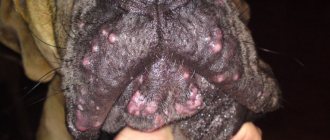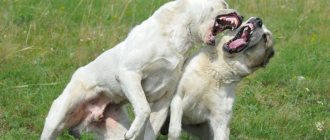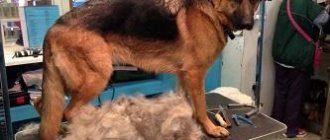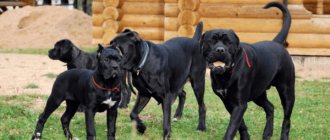Causes of color loss
Every person, even those who don’t have a pet, has an idea of what color a dog’s feces should be. The elastic consistency and brown tint, which can vary from light to dark, reflect the good functioning of the liver and gall bladder.
When something is wrong with the animal’s organs, the feces begin to lighten, and the urine takes on a rich dark hue. External signs of stool lightening:
- loss of appetite;
- manifestation of problems with the gastrointestinal tract (diarrhea, constipation, bloating);
- nausea and vomiting, regurgitation;
- yellowing of the mucous membranes and sclera of the eyes.
The dog may show anxiety; when the first symptoms and changes in the dog’s behavior appear, observe the dog and its habits. If they change without reason, conduct a visual inspection of the animal.
Gray diarrhea in a dog: Causes
Typically, the color of stool depends on the presence of processed bile in it, primarily the pigment stercobilin. Also, the color can change due to impurities, for example, if there is bleeding in the stomach or small intestine, the stool will turn black - this is the so-called melena. Discoloration to gray may be due to impaired flow of bile into the duodenum.
This can happen for a number of reasons:
- Stricture or blockage of the biliary tract. Narrowing can occur due to inflammation, and obstruction can be caused by stones, clots, or neoplasms.
- Hepatitis.
- Cholecystitis.
- Pancreatitis.
- Tumor lesions of the liver, gall bladder, pancreas.
In addition to disruption of bile flow, there may be other reasons:
- Eating large amounts of monotonous food, especially fatty foods.
- Taking certain medications. For example, drinking barium sulfate to diagnose diseases of the digestive system.
- Changes in the quantitative and qualitative composition of the intestinal microflora.
"Shades" of white feces
Any change in color, the presence of inclusions, the appearance of mucus and plaque is a deviation in the functioning of the dog’s body.
The following types are distinguished according to structure and color:
- Feces covered with a white coating, or crumbly white feces - an excess in the nutrition of the bones, the possible appearance of parasites.
- Liquid white-gray or yellowish stool - improper diet, disruption of the gastrointestinal tract.
- White mucus is a disease of the large intestine or the presence of worms, an excess of connective tissue in the body (after a large consumption of stringy meat).
- Sometimes the owner can see white specks in brown stool. These could be pieces of undigested food or worms, if prevention has not been done for a long time.
Often the process of the appearance of feces is accompanied by the sounds of gases escaping from the rectum.
Harmless causes of light-colored stool
Very often, the reason can be harmless and will not require the owner and the dog to visit a veterinary clinic.
Causes that can be eliminated without treatment:
- Eating foods high in fat for animals - lard, fatty meat, dairy products, cheese, pork. Animal fat is poorly digestible and leads to light-colored stool.
- Constant nutrition of bones. Hard and spicy foods negatively affect the functioning of the gastrointestinal tract and liver. If bones are constantly present in your dog's food, the stool will be hard and white. After changing the diet within 3 days, the stool returns to its normal consistency and color.
- Long-term treatment with drugs that affect the liver. To treat stomach diseases or diarrhea, animals are prescribed Smecta, Augmentin and other drugs. After completing the course of treatment, it is enough to add lactobacilli to the food, which will help the liver restore its protective functions.
- Dehydration – in addition to loss of color, feces become dry.
Mucus in the stool of a Chihuahua puppy
, Moscow
322 views
October 12, 2020
Hello, I ask for your help and advice. At the end of July we adopted a puppy from the kennel. Chihuahua (2 months old at that time) Brought home around 11 pm, the dog showed no signs of stress, he was running around, exploring the area. At night, my husband and I decided to take the baby with us (we know that this was our big mistake). Upon arrival, the puppy did not eat, he only drank a little water. Accordingly, I didn’t eat all night either. At lunchtime the next day we noticed that he was sleeping a lot and became lethargic. And then his paws began to move apart, and he practically could not stand. Fortunately, the breeder was always in touch, she told him to urgently pour sugar and water into him and take him back, otherwise a coma might occur (a drop in sugar due to the fact that he had not eaten for more than 12 hours). We gave him sugar and quickly took him back to the breeder. By the way, he had food standing there, I tried to play with him, throw food in, feed him by hand - to no avail. Refusal and that's it. They took it back to the breeder. She gave him no-shpa, injected him with glucose and slowly brought him out of this state. Two weeks later we decided to take him back, as everything had returned to normal, but the breeder said to give him “Veracol” (a homeopathic remedy) for a month. She said that the gastrointestinal tract was disrupted due to the fact that she did not eat so much. We took him in and honestly followed all the breeder’s recommendations. The food was not changed. We fed proplan for puppies with chicken (what the breeder initially fed). But the same story repeated itself here. The dog refuses to eat. I had to play with him, in the game he began to eat food. He has no appetite and eats through force. Sometimes I soaked the food. I tried to give him Proplan only with salmon - he didn’t want it either. And literally after a week of being with us again, one morning his stomach started rumbling. And it was very, very strong, you could see how the intestines were sticking out on the stomach. I called the breeder again, to which she said that this was all due to a disruption of the gastrointestinal tract and told him to give him Creon, Espumisan and Enterofuril three times a day. The dog began to sit down on the toilet frequently, and mucus came out every time. He also refused to eat. Then, when all the mucus came out in a large volume, he began to eat a little. Because of his condition, I had to take time off from work, because my heart was not in the right place, as he was the only one in this condition. I called the breeder with a cry for help, she said “this happens, most likely the dog is not suitable for the yard, bring him to me, I will watch him for a month and will sell him to the family as a second puppy.” Of course, we did not want to give him up in any way, we loved him very much and asked the breeder to observe him for a month, naturally we were ready to pay all expenses. A month passed, we took him home again. He immediately recognized the house and was happy, but his appetite remained poor. The breeder said he was “a little baby, just like his mother.” And now, three days later, the same story repeats itself. Stool with mucus, frequent sitting on the toilet. Once this mucus was even interspersed with blood. We called the doctor and they told us that we needed to switch him to natural medicine. I started cooking him turkey, rice, etc. In addition to all the medications, we give him Hilak Forte after each feeding. For a while, this problem went away, the feces were formed, the appetite for chicken or boiled beef was brutal, so to speak. But two days ago our story repeated itself again. He is active, runs, jumps. They didn’t take me outside, I couldn’t “lick” anything. At home too, mopping and vacuuming once every two days. There is an assumption that the child was torn away from his mother early (at 1.5 months he was already on drying, and did not suck milk). As the breeder says, there is no need to panic, this is simply the formation of intestinal microflora. Tell me, what should we do? I feel sorry for the baby, he is suffering. How can I help him? At the moment he is 4.5 months old.
The question is closed
months have passed
stern
breeder's recommendations
Diseases that cause white feces
The scientific name for white feces is acholic, translated from Greek as “without liver,” since it is the liver that is responsible for coloring feces. The main causes are liver and gall bladder diseases, the manifestation of early symptoms of which the owner did not pay attention to.
The problem of white feces is caused by:
- Gallstones are sand or stones in the gallbladder and/or its ducts. With their sharp and uneven edges, the stones injure the mucous membrane of the gallbladder, sometimes they close the ducts and cholestasis (stagnation of bile) begins.
- Malignant neoplasms - the presence of a tumor of an oncological nature causes disruption in the functioning of the entire body, and first of all, the outflow of bile stops.
- Cholecystitis (Cholangitis) is inflammation of the gallbladder and ducts. The dog is vomiting with a large amount of mucus. Vomit contains bile, which irritates the gastric mucosa and leads to flatulence, diarrhea and bloating. The animal becomes lethargic, moves apathetically, and fever often sets in. Due to pain inside the abdominal cavity, she often lies on her stomach, arching her back.
- Liver cirrhosis is an intensive and irreversible replacement of healthy cells by fibrous tissue.
- Hepatitis is an inflammation of liver tissue. Appears along with diseases of the stomach and pancreas. In the body, protein, carbohydrate-fat and pigment metabolism is disrupted, and organ cells disintegrate. The dog's temperature rises.
- Cholangiohepatitis is inflammation of the liver and ducts at the same time.
- Cysts are the appearance of operable benign formations that impede the normal functioning of the organ.
- Deformation of the bile ducts is a change in the normal shape or size of the gallbladder, adhesions. The disease is congenital or acquired.
- Pancreatitis is inflammation of the pancreas.
Why does a dog have white feces and what does it mean?
A change in the color of a dog's feces occurs for various reasons, and not in all cases it is a sign of pathology. If the feces have turned white, first evaluate the animal’s diet, and only then proceed to look for more serious causes of the pathology.
Diet-related reasons
Light-colored stools can be observed in pets whose diet includes regular consumption of the following foods:
- food with a large amount of animal fats (in particular, pork, fatty sour cream, hard varieties of industrial cheeses and fatty broths, which negatively affect the functioning of the pancreas and liver of pets of any age, but especially puppies);
- bones, even after the main meal (their introduction into the daily menu disrupts the functioning of the gland and gastrointestinal tract, causing the poop not only to turn white, but also to change its consistency to a very hard one);
- dry food with a limited amount of liquid (the dog will poop a crumbly white substance).
Sometimes, while the main part of the fecal matter is white, it has a yellow tip, which indicates a large amount of bile in the body. After changing the pet's menu and using probiotics (which help normalize the microflora of the stomach and intestines), everything should return to normal. This also applies to cases of normal-colored stool with white inclusions, which may well turn out to be unprocessed food particles.
Did you know? In veterinary medicine, white feces are usually called acholic, which literally translated from Greek means “without bile.”
Taking medications that affect the liver
When understanding why your dog’s feces have acquired a whitish tint, it is worth considering the option of taking certain medications that have a bad effect on the functioning of the liver. Thus, similar consequences are caused by prolonged use of Smecta or the drug Augmentin, which is used in the treatment of joints and for recovery in the postoperative period. In addition, long-term use of any antibiotics often causes disruption of the normal functioning of the gastrointestinal tract, which means the color of feces should change after stopping taking such medications.
Additional symptoms of the disorder include dysbacteriosis, allergic reactions on the surface of the body, disruption of digestive processes, and sometimes even severe intoxication of the body (characteristic manifestations are nausea and vomiting).
Possible diseases
If none of the above can serve as a basis for a change in the color and structure of your pet’s stool, you should think about the possibility of developing more serious disorders in the animal’s body.
Among the most popular reasons for the atypical color of feces in this situation are the development of the following diseases:
- cholelithiasis, characterized by the formation of sand and stones in the gallbladder or excretory ducts (in addition to “non-standard” feces, vomiting and pain when palpating the abdomen, deterioration of the condition of the coat and skin, and lethargy of the animal may occur);
- oncological lesions of the liver and gall bladder (any neoplasms negatively affect the functioning of the dog’s body, disrupting the normal excretion of bile);
- liver cirrhosis is a process characterized by a change in the structure of the gland tissue to a fibrous type, which negatively affects the functioning of the organ (accompanying manifestations of white poop in this case are: loss of appetite, nausea and vomiting, increased gas formation and severe fatigue);
- cholangitis - an inflammatory process in the gallbladder and its ducts, expressed in hyperthermia, severe pain in the liver, upset stool, with simultaneous whitening;
- hepatitis - a serious disease of the gland (in addition to white feces, you may notice an upset stomach, severe thirst, general weakness and increased body temperature);
- cysts on the liver are benign tumors that disrupt the normal functioning of the organ and can lead to the development of the symptoms described above;
- Cholangiohepatitis is a simultaneous inflammation of the liver and bile ducts, accompanied by disruption of the gastrointestinal tract and an increase in body temperature.
- deformation of the biliary tract is an acquired or congenital ailment, expressed in a change in the normal size and shape of the gallbladder.
Sometimes white inclusions in feces or almost complete whitening of feces indicate the initial stage of development of pancreatitis, that is, inflammation in the pancreas.
Important! Many ailments have similar symptoms.
Therefore, if the owner thinks that he knows what he is faced with, he should not prescribe any medications to his pet on his own. Consultation with a veterinarian is always mandatory.
Owner behavior - prompt assistance
If you see white feces on your dog for the first time, there is no need to panic. Analyze all the reasons for its appearance and observe the animal for 2-3 days. If your dog's stool does not change and his behavior becomes alarming, consult a doctor.
Before prescribing treatment, the veterinarian will ask the animal to conduct the following tests:
- urine and blood to identify inflammatory processes and the condition of the liver; in difficult cases, instead of a general study, a biochemical study will be performed;
- stool and biochemical urine analysis to determine the condition of the pancreas;
- if neoplasms are suspected, ultrasound of the abdominal cavity;
- X-ray of the liver or in some cases a biopsy.
Based on research results, doctors prescribe treatment in several areas:
- Antibiotic therapy (Trichopol, Cephalexin).
- Choleretic (Allohol, Holosas).
- Hepatoprotectors (Hepatoject, Hepatovet).
- Antispasmodics and analgesics (No-Shpa, Baralgin, Butofanol).
- Enzymes (Mezim, Creon).
If the presence of a cyst or cancerous tumor in an animal’s body is confirmed, surgery is always performed.
Treatment of diseases in which dogs have light-colored stools
The entire process of treating an animal consists of two main parts: adherence to a strict diet and the use of medications to combat the specific disease detected. Each of them will have its own characteristics, which not only the doctor, but also the pet owner should know about.
Diet during treatment
Dietary nutrition is a prerequisite for the treatment of any gastrointestinal ailments or disorders of the digestive organs. For this reason, if the occurrence of white feces is combined with diarrhea, the animal is not fed during the first 24 hours of treatment, periodically giving it only a decoction of chamomile. On the second day, you can add chicken broth to the menu and make puree from lean meat. Starting from the third day, low-fat, unsweetened cottage cheese is added to it, which gives the body energy to fight the disease. Among vegetables for further feeding the dog, boiled carrots and potatoes (together or separately) will be relevant.
Fatty, salty and spicy foods are prohibited, both at the initial stages of treatment and in the future. The same applies to ready-made industrial food with a sweetish aftertaste, although complete dietary mixtures from leading manufacturers of high-quality dog food are welcome. When an animal consumes ready-made dry food, there should always be clean water next to the pet, access to which will be unlimited at any time of the day. However, this recommendation is also relevant when using natural food, especially in the hot season.
Find out in more detail what dogs can get sick with: infectious, parasitic and other diseases.
Use of medications
Prescribing medications for a specific dog is based on the diagnosis. For example, for confirmed inflammation of the liver and ducts, Trichopolum, antibiotics Cephalexin, Trimethoprim, as well as hepatoprotectors (for example, Hepatovet, Hepatoject), antispasmodics and painkillers - No-shpy or "Butorphanol". To restore the normal microflora of the intestines and stomach, the pet is prescribed enzyme preparations (Creon or Mezim).
Surgical intervention is indicated only in the most difficult cases:
- if stones are found in the gall bladder (sand is quite successfully removed with medications and specially selected dietary foods);
- neoplasms compressing the liver have been diagnosed (cysts that do not limit the animal’s full life activity cannot be removed; they will only have to be re-examined from time to time to monitor their growth).
Surgical removal of a malignant neoplasm will be appropriate only if there are no metastases in the dog’s body. If they are present, the risks of intervention are too great, and the operation is unlikely to save the animal. Treatment of inflammation and elimination of other causes for which drug therapy would be appropriate is carried out at home, but under the constant supervision of a veterinarian. Clinic visits are usually scheduled on the third, fifth, and seventh days of treatment, and post-treatment screening examinations are scheduled no earlier than 4–6 weeks after completion of the treatment course.
Did you know? Among dogs, just like among people, there are pessimists and optimists. Scientists were helped to verify this by the results of studies in which some animals sought to search all places where a treat could be found (even if the probability of food being present in them was only 50%), while others preferred not to waste energy on this.











